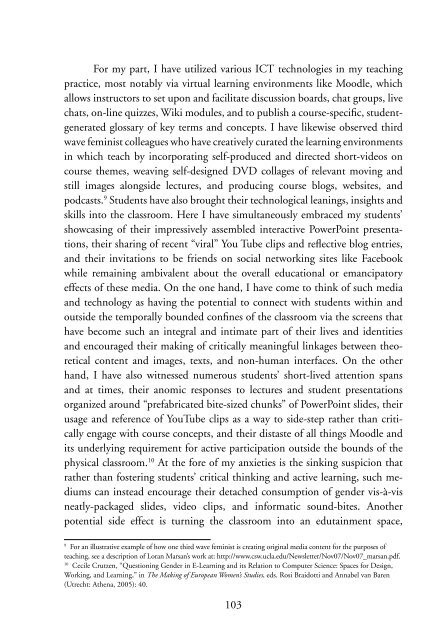Teaching with the third wave new feminists - MailChimp
Teaching with the third wave new feminists - MailChimp
Teaching with the third wave new feminists - MailChimp
You also want an ePaper? Increase the reach of your titles
YUMPU automatically turns print PDFs into web optimized ePapers that Google loves.
For my part, I have utilized various ICT technologies in my teachingpractice, most notably via virtual learning environments like Moodle, whichallows instructors to set upon and facilitate discussion boards, chat groups, livechats, on-line quizzes, Wiki modules, and to publish a course-specific, studentgeneratedglossary of key terms and concepts. I have likewise observed <strong>third</strong><strong>wave</strong> feminist colleagues who have creatively curated <strong>the</strong> learning environmentsin which teach by incorporating self-produced and directed short-videos oncourse <strong>the</strong>mes, weaving self-designed DVD collages of relevant moving andstill images alongside lectures, and producing course blogs, websites, andpodcasts. 9 Students have also brought <strong>the</strong>ir technological leanings, insights andskills into <strong>the</strong> classroom. Here I have simultaneously embraced my students’showcasing of <strong>the</strong>ir impressively assembled interactive PowerPoint presentations,<strong>the</strong>ir sharing of recent “viral” You Tube clips and reflective blog entries,and <strong>the</strong>ir invitations to be friends on social networking sites like Facebookwhile remaining ambivalent about <strong>the</strong> overall educational or emancipatoryeffects of <strong>the</strong>se media. On <strong>the</strong> one hand, I have come to think of such mediaand technology as having <strong>the</strong> potential to connect <strong>with</strong> students <strong>with</strong>in andoutside <strong>the</strong> temporally bounded confines of <strong>the</strong> classroom via <strong>the</strong> screens thathave become such an integral and intimate part of <strong>the</strong>ir lives and identitiesand encouraged <strong>the</strong>ir making of critically meaningful linkages between <strong>the</strong>oreticalcontent and images, texts, and non-human interfaces. On <strong>the</strong> o<strong>the</strong>rhand, I have also witnessed numerous students’ short-lived attention spansand at times, <strong>the</strong>ir anomic responses to lectures and student presentationsorganized around “prefabricated bite-sized chunks” of PowerPoint slides, <strong>the</strong>irusage and reference of YouTube clips as a way to side-step ra<strong>the</strong>r than criticallyengage <strong>with</strong> course concepts, and <strong>the</strong>ir distaste of all things Moodle andits underlying requirement for active participation outside <strong>the</strong> bounds of <strong>the</strong>physical classroom. 10 At <strong>the</strong> fore of my anxieties is <strong>the</strong> sinking suspicion thatra<strong>the</strong>r than fostering students’ critical thinking and active learning, such mediumscan instead encourage <strong>the</strong>ir detached consumption of gender vis-à-visneatly-packaged slides, video clips, and informatic sound-bites. Ano<strong>the</strong>rpotential side effect is turning <strong>the</strong> classroom into an edutainment space,9For an illustrative example of how one <strong>third</strong> <strong>wave</strong> feminist is creating original media content for <strong>the</strong> purposes ofteaching, see a description of Loran Marsan’s work at: http://www.csw.ucla.edu/Newsletter/Nov07/Nov07_marsan.pdf.10Cecile Crutzen, “Questioning Gender in E-Learning and its Relation to Computer Science: Spaces for Design,Working, and Learning,” in The Making of European Women’s Studies, eds. Rosi Braidotti and Annabel van Baren(Utrecht: A<strong>the</strong>na, 2005): 40.103
















